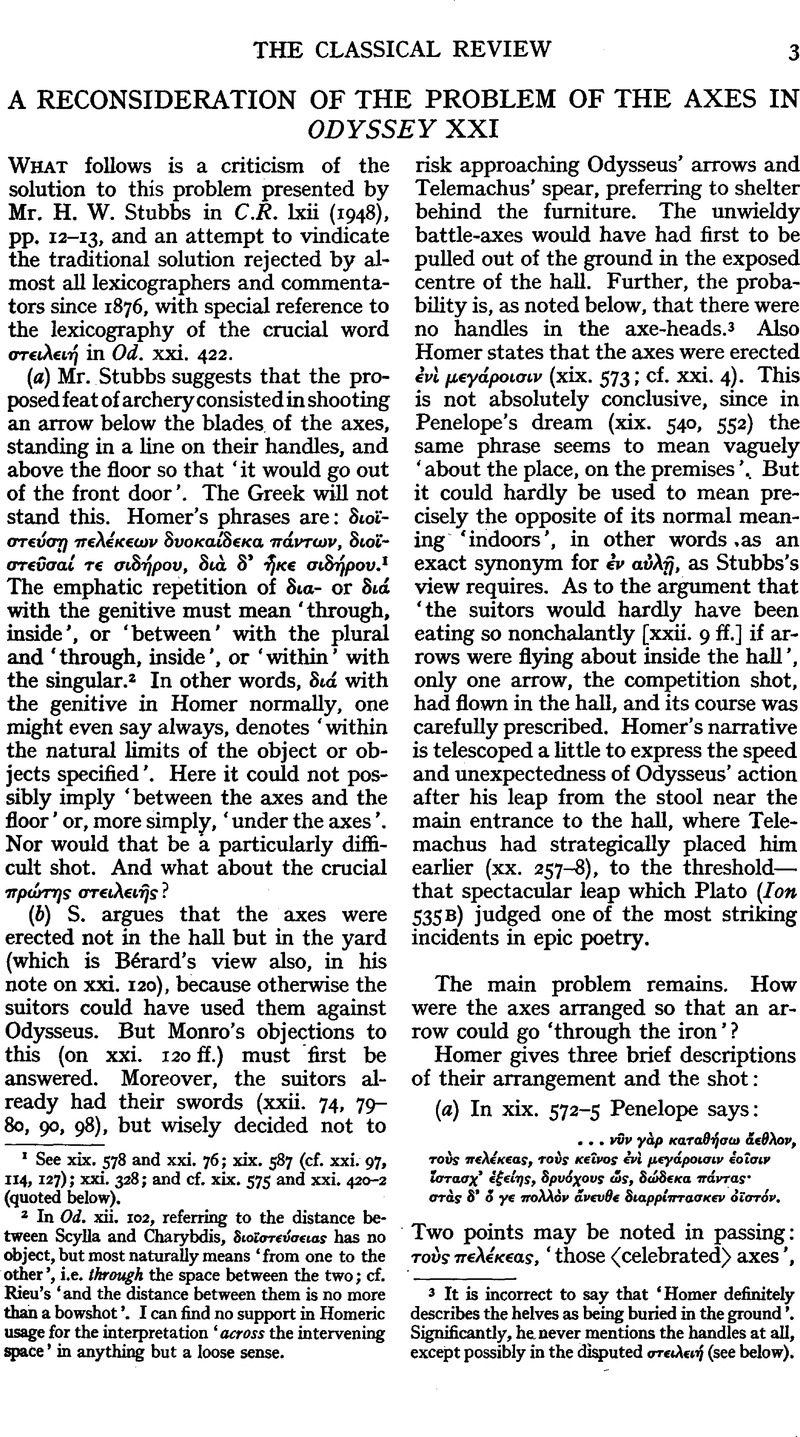No CrossRef data available.
Published online by Cambridge University Press: 27 October 2009

page 3 note 1 See xix. 578 and xxi. 76; xix. 587 (cf. xxi. 97, 114, 127); xxi. 328; and cf. xix. 575 and xxi. 420–2 (quoted below).
page 3 note 2 In Od. xii. 102, referring to the distance between Scylla and Charybdis, διοϊστε⋯σειας has no object, but most naturally means ‘from one to the other’, i.e. through the space between the two; cf. Rieu's ‘and the distance between them is no more than a bowshot’. I can find no support in Homeric usage for the interpretation ‘across the intervening space’ in anything but a loose sense.
page 3 note 3 It is incorrect to say that ‘Homer definitely describes the helves as being buried in the ground’. Significantly, he never mentions the handles at all, except possibly in the disputed στειλει⋯ (see below).
page 4 note 1 See scholia and Eustathius on xix. 574; Etymologicum Magnum, s.v.; Apollonius, Lex. 60. 23, as well as the references in LS9, I am grateful to Mr. W. R. Smyth for helphere-and elsewhere in this article.
page 4 note 2 It is astonishing that LS9, Cunliffe, and Autenrieth do not list the second meaning, which is clearly indicated in Od. v. 234–6 and ix. 391, and expounded in Eustathius 1879.7 f.Eustathius also notes (1878. 40 f.: cf. schol. on Il. xxiii. 850) that the word can mean a kind of weight (cf. Hesychius on ⋯μιπ⋯λεκκον and Leaf on Il. xxiii. 851 ff.), which introduces the remote possibility that what Odysseus shot through was not a row of axes at all.
page 5 note 1 e.g. Merry, Hamilton, Hentze, Monro,. Hesychius on Autenrieth, Helbig, Cunliffe, LS9 (the 8th edition having given the old view). It is significant that in 1890 Van Leeuwen and Da Costa emphatically followed Goebel, but in 1917 Van Leeuwen, realizing the importanceof the repeated δι⋯ σιδ⋯ρον, returned to the traditional interpretation.
page 5 note 2 Schneider reads the neuter στειλει⋯ν (see below). There is a similar uncertainty in Alexipharmaca 46, where καυλ⋯ον has a v.l.καυλ⋯α.
page 5 note 3 There is a lacuna here. But the most recent editors, Hunter and Handford, who had no Homeric axe to grind, emend so as totake στελε⋯ as ‘handle-hole’, citing Casaubon and Stephanus in their favour. They refer to some unpublished notes by Herbert W. Greene as supporting the new view. These notes were presumably the cause of the change in LS9 (see Preface p. x).
page 5 note 4 Scholia on Od. xix. 578, xxi. 422; Eustathius 1531. 35 f., 1879. 7f., I915. 37 f., Etym. Mag 726. 52; Moeris 254; Hesychius s.v. (despite the gloss cited above); and cf. schol. on Il. xxiii. 851.
page 5 note 5 ⋯πἠ is not attested for Homer, except possibly in ἀνοπαῖα. I mention here with diffidence and without elaboration that a primitive sexual symbolism might be involved in the use of feminine forms in such word-groups, as, for example, in ⋯π⋯ ὂπεας τρ⋯πα τρ⋯πανον (but also τρυπ⋯νη). Similarly firemen speak of the part of a hose into which the ‘male’ end fits as the ‘female’ end. Freudians could pursue a lively ποταν⋯ν ⋯ρνιν by treating the whole competition for Penelope as a congeries of symbolisms.
page 6 note 1 Or possibly Homer, aiming at τ⋯ εἰκ⋯ς not δυνατ⋯ν, ignored the inevitable drop in trajectory and πρωτ⋯ς στ. simply means ‘the nearest handlehole’. The drop would not be great if the axes were close together, in a row of, say, about 18 feet long.
page 6 note 2 See Goebel, loc. cit.; Butcher and Lang, p. 419, 1893 edn.); Monro, p. 176.